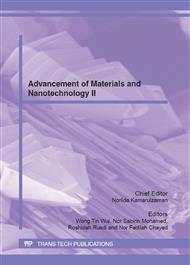p.43
p.50
p.59
p.64
p.71
p.76
p.81
p.88
p.93
Growth of ZnO Nanostructures at Different Reactant Concentrations for Inverted Organic Solar Cell
Abstract:
The effects of reactant concentration on the growth of ZnO nanostructures and the photovoltaic performance of inverted organic solar cells based on a blend of poly[2-methoxy-5-(2-ethylhexyloxy)-1,4-phenylenevinylene] (MEHPPV) as donor and (6,6)-phenyl-C61 butyric acid methyl ester (PCBM) as acceptor with a structure of FTO/ZnO nanostructures/MEHPPV:PCBM/Ag utilizing ZnO nanostructures as electron collecting layer and silver as a hole collecting electrode were investigated. The ZnO preparation consisted of ZnO nanoparticles seed layer coating and followed by ZnO nanostructures growth in equimolar aqueous solution of zinc nitrate hexahydrate (0.02-0.08 M) and hexamethylenetetramine (0.02-0.08 M). ZnO nanorods having diameter of 50-70 nm and with length up to 120 nm were obtained at reactant concentration of 0.04 M. The ZnO nanorods started to merge with each other and formed irregular nanostructures vertically on the substrates at higher reactant concentrations of 0.06 M and 0.08 M. The solar cell with ZnO nanorods prepared at reactant concentration of 0.04 M provided the largest interface area between polymer active layer and ZnO, resulting in the highest power conversion efficiency of 0.053 % with short circuit current density of 0.43 mA/cm2, open circuit voltage of 0.42 V and fill factor of 29 %.
Info:
Periodical:
Pages:
71-75
Citation:
Online since:
July 2012
Authors:
Price:
Сopyright:
© 2012 Trans Tech Publications Ltd. All Rights Reserved
Share:
Citation:



